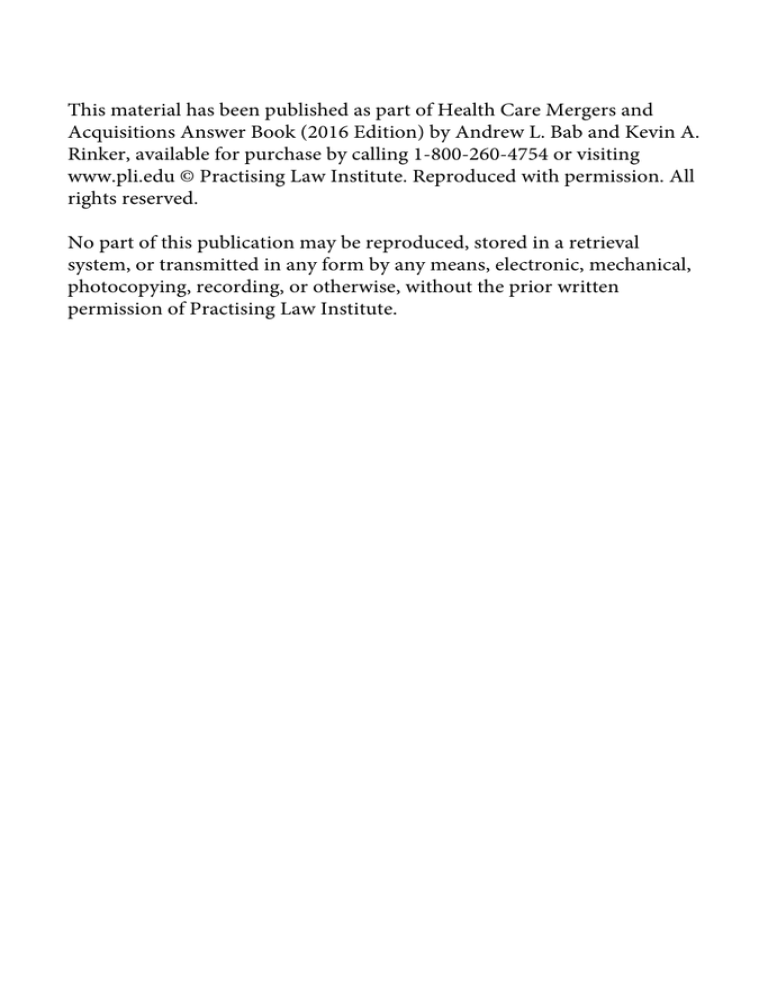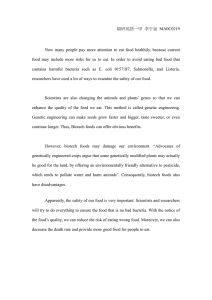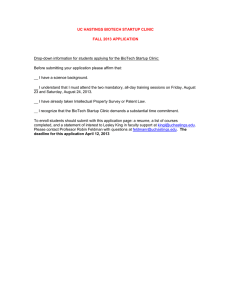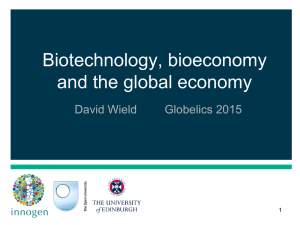
This material has been published as part of Health Care Mergers and
Acquisitions Answer Book (2016 Edition) by Andrew L. Bab and Kevin A.
Rinker, available for purchase by calling 1-800-260-4754 or visiting
www.pli.edu © Practising Law Institute. Reproduced with permission. All
rights reserved.
No part of this publication may be reproduced, stored in a retrieval
system, or transmitted in any form by any means, electronic, mechanical,
photocopying, recording, or otherwise, without the prior written
permission of Practising Law Institute.
© Practising Law Institute
11
Financing Drug Development
Mark Kessel & Robert Masella
The biopharmaceutical industry is bifurcated—big pharmaceutical companies (“big pharma”), with anemic product
pipelines but plenty of cash, and the biotech sector, which is
often cash-constrained but with rich pipelines.
Big pharma’s blockbuster drugs are losing patent protection and
facing generic competition. The pharmaceutical companies
are desperate for replacement drugs, which are not coming
out of their own pipelines. Health care reform has placed
additional pressure on prices, coupled with the imposition of
pay for performance; and earnings pressure is causing big
pharma to reduce its own research and development (R&D)
efforts.
At the same time, biotech companies may face a major challenge in securing financing for drug discovery and development, jeopardizing the progress of the very drugs that big
pharma desperately needs. Unlike product development in other
technology-driven companies, biotech product development
211
© Practising Law Institute
Q 11.1
Health Care Mergers & Acquisitions AB 2016
is highly regulated and the development cycle for a drug can
be as long as fifteen years, with cost estimates as much as
$1 billion or more. Also, it is rare for a biotech company to
be able to commercialize its own product due to the lack of
a global sales force, among other things.
This chapter addresses how both kinds of companies are reacting to these challenges. It describes some historical patterns of
financing, and some newer alternatives. It also discusses the
collaborative efforts that stem from big pharma’s increasing
need to rely on the drugs being developed by the biotech
companies, and the biotech companies’ need to monetize
their portfolios through a sale or licensure to big pharma.
Background������������������������������������������������������������������������������� 212
Financing from Seed Capital to Initial Public Offering��������������������� 213
Post-IPO Financing for Public Biotech Companies��������������������������� 216
Licensing and Other Collaborations Between Pharmaceutical
and Biotech Companies�������������������������������������������������������� 218
More Financing Alternatives�������������������������������������������������������� 220
Background
Q 11.1 How have companies addressed recent
developments in the biopharmaceutical
industry?
In response to current conditions, including the lack of new drugs
being developed in house, big pharma has reacted in a number of
ways:
•
Buying earnings through acquisitions;
•
Expanding in emerging markets like China, Brazil, India, and
other underpenetrated markets, which are projected to increase
more dramatically than the U.S. and European markets;
212
© Practising Law Institute
Financing Drug Development
Q 11.2
•
Entering into the ever-growing generics market;
•
Expanding into branded biologics which are likely to retain
market share even after patent expirations;
•
Increasing focus on orphan drugs, which, while targeting
small indications, can be highly profitable;
•
Investing in biosimilars or follow-on biologics which are less
competitive due to barriers to entry and thus attractive
investments; and
•
Restructuring R&D activities to reduce overhead, a short-term
solution to earnings improvement.
But for purposes of this chapter, the important change is big
pharma’s greater reliance on externally developed drugs, such as can
be provided by the biotech companies.
The fact that big pharma is turning to externally developed drugs
may be viewed as boding well for the biotech companies. But the
transactions may carry lower multiples than were enjoyed in the
past, be structured with contingent payments based on value creation
milestones, or provide for a major portion of the purchase price to be
contingent on the successful commercialization of the drug.
In turn, biotech companies seeking drug development financing are
turning to big pharma partnerships as a funding source, licensing away
promising drug candidates to fill big pharma’s draining pipeline (see
QQ 11.7–11.11). Additional financing alternatives are also available
(see QQ 11.12–11.12.4 ).
Financing from Seed Capital to Initial Public
Offering
Q 11.2 How has the industry financed drug
development historically?
Historically, the biotech industry was able to fund its capital
needs from multiple sources, depending on a company’s stage of
development. Seed capital was provided from various sources, such as
213
© Practising Law Institute
Q 11.3
Health Care Mergers & Acquisitions AB 2016
the inventor, “friends and family,” angel investors, and governmental
grants, in amounts aggregating generally under $5 million, which would
typically carry the company through early stages of development.
Venture capitalists would provide the next stage of funding to the
tune of $20–$30 million, for the next three to five years of early-stage
clinical trials.
As the drugs continued to advance through the development
cycle, the public markets would become receptive to an initial public
offering (IPO), funding further drug development efforts.
Q 11.3 What is the current role of angel investors?
As a compound advances through the various stages of development, each milestone provides an opportunity for raising additional
capital at potentially increased valuations. This financial life cycle
starts with an initial funding of a scientific discovery—“seed capital.”
An important source of seed capital is angel investors: high-networth individuals who constitute a major source of startup capital,
until venture capital financing can be attracted. Historically, the
amounts of funding were modest, but they have been increasing to
replace later-stage funding, which can be significantly more dilutive
to early investors than was previously the case.
Angel investors in biotech companies often are retired executives
from the industry who have accumulated significant capital or are
entrepreneurs. These investors provide business acumen to the founders
of biotech companies, as well as relevant industry networking. In
more recent periods, these investors have formed informal networks
furthering the raising of capital in a more efficient manner.
Q 11.4 What is the current role of venture capital?
As drug development approaches human clinical trials, the capital
requirements increase significantly beyond that made available by
angel investors.
Venture capital, once scarce, has become more readily available
for earlier-stage compounds. Global venture funding of private biotech companies reached $7.7 billion in 2007, a peak year, and climbed
214
© Practising Law Institute
Financing Drug Development
Q 11.5
to $10 billion in 2015.1 During the meltdown in the financial markets,
valuations were significantly lower, and the IPO market was closed.
Whether the surge in venture capital funding will continue will depend
upon continued advances in science and perceptions regarding the
strength of the M&A market and the IPO market in the mid-term. Some
of the big pharma players have set up their own venture capital divisions to give them a leg up in competing to in-license promising compounds that the biotechs in which they invest may develop, and this
activity may place a floor under venture capital financing activity. In
the event of a step-back by traditional venture capital players, these
investment vehicles will have further opportunity to exert their financial capabilities.
Q 11.5 What is the current role of initial public
offerings?
The critical issue for the biotech sector is whether the IPO market,
which was strong in both 2013 and 2014, will rebound from declines
in 2015 and a weak start in the beginning of 2016. Positive investor
sentiment and the 2012 Jumpstart Our Business Startups Act (JOBS
Act),2 designed to reduce the burden on smaller companies, helped
fuel the IPO pipeline in 2014 and early 2015. However, M&A activity
and a slowdown in the IPO market during the second half of 2015 led
to an overall decrease of approximately 10% in the number of global
biotech IPOs in 2015.3
When the IPO window is open, investors have tended to favor
health care–focused companies. Health care IPOs comprised one of
the largest segments of the IPO market in 2015 as investors focused on
companies that had the potential for significant growth and future exit
opportunities through M&A. If the global markets remain unsettled,
there is a question whether public equity investors will have an appetite
for higher-risk equities such as early-stage biotech companies.
215
© Practising Law Institute
Q 11.6
Health Care Mergers & Acquisitions AB 2016
Post-IPO Financing for Public Biotech
Companies
Q 11.6 What financing needs exist after the initial
public offering?
Public biotech companies have a continual need for capital to
advance their drugs through clinical trials. Aside from the large-cap
companies with meaningful revenues and liquid markets for their
securities at attractive pricing, biotech companies have come to rely
on multiple sources of alternative capital, not all of which are available
at any given point in time and some of which are extremely dilutive
to existing shareholders.
Q 11.6.1
What is a follow-on offering?
A common way for a biotech company to raise equity after having
completed an IPO is to do a follow-on offering—issuing additional shares
of common stock to public investors—which can be underwritten by
investment banks. The ability to access this form of capital is subject
to the vicissitudes of the public markets and may entail significant
discounts from the prevailing trading price, particularly for earlystage companies.
Q 11.6.2
What is a registered direct offering?
Another way to access equity is a registered direct offering (RDO),
which is a public offering marketed by a placement agent on an agency
basis to a limited number of institutional investors.
Q 11.6.3
What are private investments in public equity?
Private investments in public equity (PIPEs) are also done with
institutional investors, including private equity, but are often done
on more investor-friendly terms, such as additional discounts and
preferences (for example, a convertible preferred security). However,
PIPEs can be implemented more quickly and less expensively than
underwritten offerings.
216
© Practising Law Institute
Financing Drug Development
Q 11.6.6
As an additional incentive to investors, typical PIPE transactions
also include warrants to purchase additional shares at some premium to
the purchase price of the PIPE shares and/or attractive conversion
prices if a convertible security is involved, with significant antidilution
protection. Health care represented one of the largest segments of the
total PIPE market in 2015, as companies took advantage of relatively
favorable pricing terms in the first nine months of the year. If the market continues to experience significant volatility, the terms afforded to
companies will become less favorable and the PIPE market will slow.
Q 11.6.4
What are at-the-market offerings?
At-the-market offerings (ATMs), which have become more popular,
comprise a registered offering of listed securities sold directly into the
public markets through a broker-dealer over a period of time. They
usually involve a small number of shares being sold at the company’s
discretion on any given day at prevailing market prices, allowing the
company to average its cost of capital over time at lower commissions
than the other types of financings discussed in this chapter.
Unlike PIPEs, ATMs do not include warrants and there are no
discounts to the investors.
Q 11.6.5
What are committed equity financing facilities?
A committed equity financing facility (CEFF) allows a biotech
company to sell a specific dollar amount of equity securities to an
investor over a period of time. The company can determine in its
discretion the timing, dollar amount, and floor price for any draw
under the facility, based upon a contractual formula tied to a volumeweighted average price of the common stock over a multiday pricing
period.
Q 11.6.6
What other forms of equity financings are used to
raise capital?
Preferred stock and convertible debt securities offer investors the
opportunity to be senior to common stock and contain tailored terms
and conditions depending on the requirements of investors and the
financial strength of the biotech company.
217
© Practising Law Institute
Q 11.7
Health Care Mergers & Acquisitions AB 2016
Licensing and Other Collaborations Between
Pharmaceutical and Biotech Companies
Q 11.7 Why is licensing becoming more attractive to
big pharma?
Historically, big pharma’s licensing was limited for several reasons:
reluctance to partner outside of internal competencies; a bias to
exploit internally developed drugs; and earnings constraints that
tempered a desire to fund external programs.
With big pharma’s declining internal R&D productivity, the everincreasing cost of developing drugs, and the pressure on earnings,
big pharma has increasingly turned to licensing drugs from biotech
companies. This is especially the case for companies that have decided
to restructure their internal R&D resources to reduce overhead costs.
For big pharma, collaborating with biotech via licensing provides
an opportunity to replenish pipelines at a time when many blockbuster
drugs are coming off patent and beginning to face generic competition.
Q 11.8 What can big pharma and biotech companies
each contribute in a collaboration?
A collaboration can provide an opportunity to tap the strengths
of both big pharma and biotech companies. Biotech companies are
known for their entrepreneurial business model and agility in developing drugs. Big pharma’s prowess lies in its global scope for the
commercialization of drugs, ability to provide significant amounts
of capital, experience in running worldwide clinical trials, and broad
expertise—scientific, medical, and regulatory. A collaboration also allows
biotech companies to finance drug development without incurring
excessive dilution through equity offerings.
Q 11.9 At what stage of drug development does a
collaboration take place?
Licensing of the intellectual property associated with a potential
drug takes place at all stages of the drug development continuum:
•
•
Research;
Preclinical (animal testing);
218
© Practising Law Institute
Financing Drug Development
•
•
•
Q 11.11
Phase 1 (testing the drug in healthy volunteers for safety);
Phase 2 (testing the drug in patients for efficacy); and
Phase 3 (large efficacy trials for registration purposes).
The licensing of later-stage drugs is associated with improved
economics for the biotech companies as the risk of potential failure
of the drug continues to diminish. Accordingly, the most coveted
drugs are those in the latest stage of development—phase 3—with
blockbuster potential (sales in excess of $1 billion annually).
Q 11.10 What terms can be expected in a licensing
transaction?
The basic components of a licensing transaction between a biotech
company and big pharma may include:
•
An up-front payment upon the grant of the license;
•
Funding of further development of the drug;
•
Milestone payments tied to further development of the drug,
such as filing for regulatory approval, receipt of such approval,
and commercial launch of the drug;
•
Milestones and/or royalties tied to sales;
•
Investments in equity or debt of the biotech company; and
•
More rarely, co-promotion or co-marketing rights.
Q 11.11 When are contingent value rights used?
At times, it is more advantageous to big pharma and biotech companies to enter into a business combination rather than a licensing
transaction. To avoid over-paying in such circumstances or to share
the risk of further development of the drugs owned by the biotech
company, big pharma may pay part of the acquisition consideration
in the form of contingent value rights (CVRs). Like licenses, CVRs
provide future cash payments to the selling shareholders as milestones, typically regulatory approvals, are reached.4
CVRs can be used in acquisitions of both public and private companies as a mechanism to avoid stalemates over the inherent value of
the pipeline of the company to be acquired. They can also be used as a
form of earnout when tied to sales milestones or other financial metrics.
219
© Practising Law Institute
Q 11.12
Health Care Mergers & Acquisitions AB 2016
More Financing Alternatives
Q 11.12 What are some alternatives to dilutive
equity financing of drug development?
As securing adequate funding for drug development is always a
challenge for biotech companies, the sector has continued to seek
alternatives to dilutive equity financings. In response to their needs,
various alternative financing sources have become available, such as
venture lending, royalty-based financing, clinical research organization
financing, and structured drug development financing.
Q 11.12.1 What is venture lending?
Large biopharmaceutical companies have the ability to raise capital
through the issuance of debt securities, often convertible notes or
debentures sold in public offerings. For the small biotech companies,
including those in the venture-backed stage and micro-cap or smallcap publicly traded companies, venture debt financings may be an
attractive alternative to the issuance of equity.
These private loans, extended by a few banks and other financial
institutions, are generally amortizable over three years. They are
designed to correlate to the development pipeline, so that as the
company progresses to the next value inflection point, additional
capital in the form of equity or a licensing opportunity provides
money to meet the debt obligations. The loans are generally secured
by the intellectual property and contain financial and other covenants
to protect the lender.
Q 11.12.2 What are royalty-based financings?
For companies that (1) have revenues from the sale of drugs that
are on the market, (2) are receiving royalties on licensed drugs, or
(3) have low-risk, late-stage drugs in development (such as drugs
already approved in one jurisdiction but not in another), the sale of
revenues on future product sales or royalties can provide an attractive
source of capital. The uncertain future revenues are exchanged for
up-front capital. These financings are very flexible and can be used
to fund further development of other drugs, for acquisitions, or for
other purposes and can be meshed with secured debt in the same
220
© Practising Law Institute
Financing Drug Development
Q 11.12.4
transaction. The discount to expected sales is based on an assessment
of the risks associated with the product in question—product failure,
delay, underperformance, competition, and other factors that may
materially impact the value of the royalty stream.
Q 11.12.3 What are financings linked to clinical research
organizations?
Clinical research organizations (CROs) are engaged by the biopharmaceutical industry to further the development of and manage
clinical trials. Their contribution has thus been value-added clinical
development resources. Either directly or through affiliates, CROs may
partner with biotech companies to provide capital, or other forms of
consideration in the form of reduced service fees, to further clinical
development. These financings can be based on milestone payments,
royalties on future product sales, equity interests in the company, or
a combination of these.
Q 11.12.4 What are structured drug development
financings?
Structured drug development financings are designed to provide
both capital and drug development expertise to biotech companies
with products in early- or mid-stage development.
Under the typical structure, a biotech company licenses drugs to
a newly created drug development company (DDC) that is funded by
investors for the sole purpose of furthering the development of the
licensed drugs. In turn, the biotech company receives the exclusive
option to acquire the DDC at a prenegotiated purchase price. This
option would obviously be exercised at a time when the drugs have
shown sufficient safety and efficacy to warrant the exercise price,
thereby allowing the biotech company to capture the value of the
drugs above the purchase price for its shareholders. Development
agreements between the DDC and the biotech company may be used
to achieve a similar result.
In this form of financing, if the trials fail to achieve the intended
results, the investors in the DDC bear the loss of their capital used to
further development of the drugs. If the option is not exercised, the
investors retain all rights to the drug and can license it to third parties.
221
© Practising Law Institute
Health Care Mergers & Acquisitions AB 2016
Notes to Chapter 11
1.Huggett, Biotech’s Wellspring—A Survey of the Health of the Private Sector
in 2014, Nature Biotechnology 33, 470–77 (2015).
2. Jumpstart Our Business Startups Act, Pub. L. No. 112-106, 126 Stat. 306
(2012).
3. Bloomberg L.P., Bloomberg Professional Service, Feb. 4, 2016.
4. CVRs are discussed in more detail in chapter 2.
222





